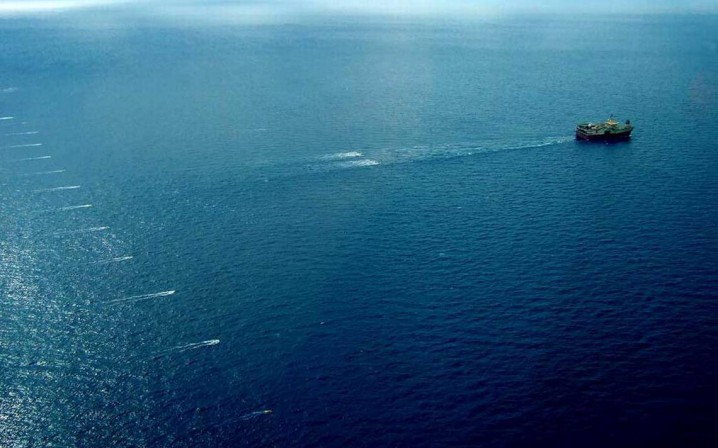Exploration for oil and natural gas in the Atlantic Ocean will cover more territory than any previous modern-day seismic testing, giving pause to environmentalists and federal regulators.
With such an expansive area of ocean floor to survey, companies currently seeking permits to conduct seismic surveys in the Atlantic will likely be working over long periods of time, raising the potential to exposing marine mammals and other aquatic life to extended periods of acoustic blasting.
Supporter Spotlight
“That’s why we’re just trying to take a very careful look at these requests,” said Ben Laws, a fishery biologist with the National Oceanic and Atmospheric Administration’s National Marine Fisheries Service in Silver Spring, Md. “You have a much larger survey in terms of the number of miles that they have to cover. With these much larger areas these folks are interested in working for a full year.”
The sheer scale and span of time seismic survey companies want to work in the Atlantic prompted NOAA, which issues seismic operations permits, to provide an unusual 30-day public review and comment period on the applications. The deadline for comments was Aug. 28.
So far five applications have been submitted for Atlantic seismic survey permits. Seismic operations are controversial because the use of sound sources may disturb marine mammals by disrupting their behavioral patterns, according to critics.
The Atlantic Ocean hosts a diversified species of marine mammals, about 30 or so that include large whales, including humpback and North Atlantic right whales, and dolphins.
These species, as well as sea turtles, are among those that could be affected by the use of air guns conducting seismic operations.
Supporter Spotlight
NOAA fisheries’ decides whether to authorize incidental “takes” – the inadvertent harming, killing, disturbance or destruction of wildlife – anticipated to occur during such testing.

Permits and authorizations for the “take” of a protected species are required under the Marine Mammal Protection Act, which protects all marine mammals, and the Endangered Species Act.
Under the act to protect marine mammals, this means examining how seismic surveying will affect overall each species or the individual population.
“When we look at the number of takes, which is in this case the exposure of an animal to sound, that number of takes has to be small,” Laws said.
There is no definitive number of takes to quantify “small.”
Fisheries experts establish what they deem an acceptable amount of takes by looking at the total number of estimated takes and comparing that to the population of each specific species.
Their conclusions will be based on various existing studies on the impacts of seismic testing on marine mammals and other ocean life.
“As in any case we look at the available scientific information,” Laws said. “Basically our standard is to use the best available scientific information. There’s a number of studies out there in the peer-reviewed literature and agency review reports and it is on a larger scale.”
The areas sought for seismic surveying in the Atlantic are substantially larger than testing sites in other seas such as the Gulf of Mexico and the Arctic.
The National Science Foundation funded a much publicized and highly controversial seismic survey this past summer off the New Jersey shore. The operation was intended to collect and analyze three-dimensional images of sediments dating back 60 million years to study sea level rise impacts.
That operational area spanned about three square nautical miles.
One of the survey applicants planning to work in the Atlantic initially sought to operate in an area spanning more than 50 square miles. “We have worked with that company to reduce the size of that survey,” Laws said.
Seismic testing uses air guns towed behind ships to send sonic waves that penetrate the ocean floor. How those waves are reflected from the bottom gives hints to the location and extent of oil or natural gas deposits below the surface.
There are different types of seismic surveys. Two-dimensional surveying is a regional means of collecting data with a single air gun array. This type of surveying can cover large areas in a short time. Two-dimensional surveys were conducted from 1966–1988 in all areas of the Atlantic Outer Continental Shelf, but technology has greatly been enhanced since those tests were performed.
A majority of the permit applicants want to run two-dimensional surveys.
There are steps that may be taken to lessen the risk of harm to marine mammals and other marine life such as sea turtles. The NMFS require seismic operators to use ramp-up and visual observations while conducting surveys.
The public will have the opportunity to review proposed incidental take authorizations. That will be the next step in the permitting review process, Laws said.
Members of the public that read the proposed authorizations will be allowed to provide relevant information – not comments opposing or supporting offshore oil and natural gas development – on the affects of seismic activity on marine life.
A decision on whether to issue the permits could come by the end of the year.







